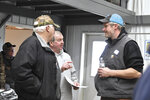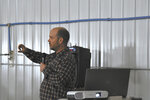


ORONOCO, Minn. — Farmers from across southeast Minnesota gathered to hear about cropping practices and nitrate reduction Feb. 23 at Tony and Michelle Rossman’s farm near Oronoco.
The event was hosted by the Byron Area Farmers Soil Health Group. The farmer-led and organized peer group focuses on improving water and soil health and shared transparency for mutual growth of their cropping successes and failures.
The first presenter was Martin Larsen. Larsen, who works for the Olmsted County Soil and Water Conservation District, is a generational crop farmer and a spelunker.
As a caver, Larsen shared examples of him rappelling 125 feet in a sink hole that was a direct conduit to a water table in the karst region and visiting a cave in Fillmore County the day after a rain, where there was the presence of milling lime on the walls of the cave from a nearby quarry.
Southeast Minnesota has karst topography, which has soft, porous rock that can result in caves and sinkholes.
“Karst is pretty much unpredictable,” Larsen said. “The way that water moves through these systems, there’s generalizations, there’s trends that occur, but it is somewhat unpredictable.”
In regard to nitrates, Larsen said that after nitrogen leaves the rooting zone, there is no removal system within the bedrock.
“Once it’s there, it’s there,” Larsen said. “Nitrate is an anion; it carries a negative charge, so it moves freely with water.”
Larsen said that groundwater nitrate levels can be predicted by the land use. In testing, they have found that certain types of land use are correlated to higher water nitrate levels below.
“When we surpass 50%-60% of row crop in the catchment area, we surpass 10 parts per million which is the drinking water standard,” Larsen said.
However, Larsen said that there are solutions that can help with nitrate leaching.
“The positive news is that cover crops, crop diversity, increasing haying and grazing are very much proven to reduce nitrates in groundwater beneath our corn and soybean or ag land,” Larsen said.
Alfalfa and well-managed grazing acres have a near zero nitrate footprint, Larsen said. Small grains and alternative crops do have a small nitrate footprint, but water below these crops is safely in the low single digits for nitrate parts per million. Finally, Larsen said cover crops reduce nitrate levels by around 30%-60%.
Larsen reported that even at the SWCD research farm where all proper nutrient management protocols for correct source, timing, rate and placement for nitrogen application were used, the nitrate levels in the water below were still too high. This came from 132 samples taken in 2018 on their corn ground, which showed an average nitrate level of 27.5 ppm. The drinking water standard is 10 ppm.
“Where it really escalates and we think of an exponential curve of loss (of nitrates out of the rooting zone) is after we go above our recommended (application) rate it exponentially climbs,” Larsen said.
The next presenters were two of the founding members of the Byron Area Farmers Soil Health Group, Aaron Pyfferoen and dairy farmer Kevin Connelly.
Connelly shared about the goals of their peer group as well as the results of their informal field trials.
In relation to nitrates, Connelly said that the group has been looking at nitrogen application rates.
“We’ve always questioned how much we really need,” Connelly said.
A member of the group has been able to reduce nitrogen down to 100 pounds per acre on corn without experiencing yield loss.
Connelly said farmers should take nitrogen credits on their manure as well as from legumes such as clover.
The group has been experimenting with cover crops. Connelly said planting soybeans into cover crops was a logical step. As a takeaway, the pair encouraged farmers to try cover crops.
“We’re going to keep finding that these covers are going to keep pulling the nitrates up (in the rooting zone),” Connelly said.
Connelly said they have been monitoring water quality in three tile lines. In 2019, when southeast Minnesota encountered a significant rain event, the tile line showed a reduction in leached nitrates on the ground with cover.
The final speaker of the day was Joel Johanningmeier. Johanningmeier has been in the agriculture industry for 34 years.
Johanningmeier spoke on nitrogen use efficiency. A takeaway from his presentation was using variable rate applications of nitrogen.
“How do we start to match up our needs even within the variations within the field?” Johanningmeier said.
The rates can be determined based on soil tests or other data, such as imagery.
The reason for the nitrate focus in the overall meeting was due to the unfolding events surrounding nitrates in southeast Minnesota.
In April 2023, a petition regarding water quality and nitrate levels in southeast Minnesota was sent to the Environmental Protection Agency by a group of environmental advocacy organizations.
Their petition resulted in the EPA sending a letter to the Minnesota Department of Health, Minnesota Department of Agriculture and the Minnesota Pollution Control Agency in November 2023.
Pyfferoen shared the tasks for the aforementioned in this letter, which included creating enhanced, long-term environmental conservation strategies.
During presentations made by Connelly and Pyfferoen, Pyfferoen expressed the group’s desire to be part of the process to plan long-term conservation efforts and to apply logic to decisions being made that could result in nitrogen taxes, use restrictions or non-economically viable solutions.
“We’re concerned about accountability for your destiny versus having it forced upon you by legislators who are so far removed from the farm,” Pyfferoen said. “We have tools today that work.”
Comments
No comments on this item Please log in to comment by clicking here